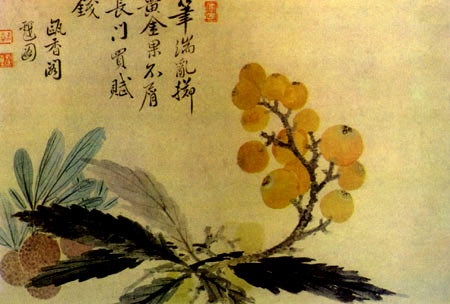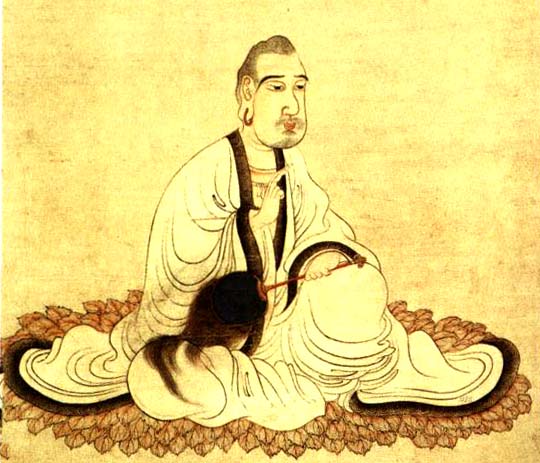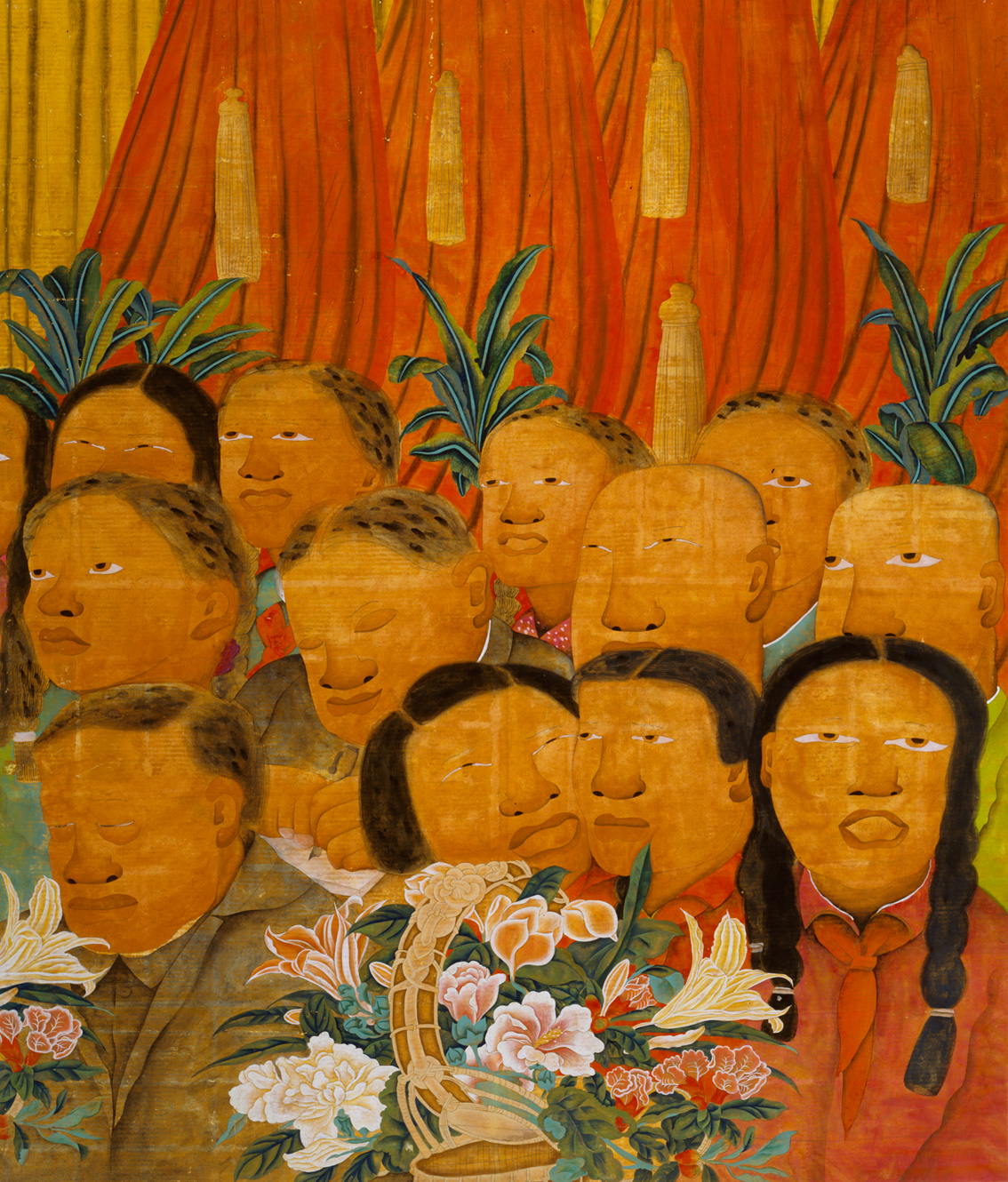|
| |
|

|
|
Modes
of Expression of Chinese Painting
Six
Cannons
The Six
Cannons were introduced by Xie He’s <Classified Record of Ancient
Painters> in the Southern Qi Dynasty, first were six standards for
measuring Figure Painting, and then applied to other genres such as
Landscape and Flower-and bird, and became the rules of modes of
expression of Chinese Painting. They may be paraphrased as: first vivid
spiritual consonance; second structural use of the brush; third proper
representation and fidelity to object; fourth specific coloring of
different objects; fifth proper planning of composition; and sixth
transmission of the past and copying.
|
| Boneless
painting
Not to use
ink brush to draw the contours of object, but directly shape the object
by dotting and dyeing with color, is the Boneless painting. There was
“Boneless Landscape” in the Tang Dynasty, and Huang Quan in the Five
Dynasties outlined the flowers with very thin lines, which almost
disappeared after coloring, thus is called boneless flowers and
branches. Northern Song Dynasty’s Xu Chongsi didn’t even outline
with ink lines when painting flowers, but only used color, was called
“boneless picture”. Yun Shouping in the early Qing Dynasty drew
experiences from both ancient and modern times, used the method in
painting flower, bamboo, poultry and worm, and carried forward the mode.
|

|
| Eighteen
Outlinings
Describes
all kinds of outlining methods of the drapes of ancient clothes. The
book <Introduction and Initiation of Painting> written by Zou
Dezhong in the Ming Dynasty says: “there are 18 methods of outlining
at all times”, which are: 1) ancient hairspring outlining (extremely
fine lines by stylus); 2) string outlining (a bit thicker); 3) wire
outlining (more thicker); 4) floating clouds and flowing water
outlining; 5) leech outlining (similar to orchid leaf outlining); 6)
nail head and mouse tail; 7) mixed traces; 8) wooden peg head (bald
brush outlining); 9) Cao’s outlining (there are two different sayings,
one says Cao Zhongda used it, one says Cao Buxing started it); 10)
folded reed outlining (slender lines by sharp brush); 11) olive
outlining; 12) jujube seed outlining (using sharp but big brush); 13)
willow leaf outlining; 14) bamboo leaf outlining; 15) trembling brush
watermark outlining (rough bold coarse brush); 16) coarse brush; 17)
firewood brush (another kind of rough bold coarse brush); 18) earthworm
outlining. The outlining methods above are named according to the shape
of brushstrokes used by Figure painters from all times and schools to
illustrate the clothes drapes.
|
|

|
Outline
Sketching
A term for
brushwork in Chinese Painting. A stroke going along is called
“draw”, and going athwart is called “carve”; or a single stroke
is “draw”, and back stroke is “carve”; or a stroke from left to
right is “draw”, while a stroke from right to left is “carve”.
Usually it’s used to sketch the contours of object. Color is added
after outline sketching, equivalent to “boneless” and “spotting
and clustering” in technique. Since any object’s outline is
basically sketched with two strokes join together, one left and one
right, or one up and one down, so it’s also called “double draw”.
Outline sketching requires powerful strokes, <The Postscript of
Dadizi Inscription Poem> written by Yuan Ji in the Qing Dynasty says:
“sketching led by enlightened spirit, the brush lines are similar to
that of seal character and official script.”
|
| Technique
of Drawing
Chinese
Painting relies much on the techniques of brushwork. The formal
aesthetic requirements for brush strokes are: number one is withered but
moist, means the lines should be both vigorous and rich and smooth,
withered strokes take the spirit and wet strokes take moisture; number
two is to couple toughness with gentleness, means the strokes be able to
“linger (left and right) and pitch (up and down), hold the
unrestrained spirit, tough as iron lines and gentle as silver curves”
(said Ouyang Xun), so to reach the highest formal aesthetic state of
brushworks; number three is to have both character and rhyme, to achieve
the unity of content and form, the figure of object virtually has the
rhyme of line movement.
|
| Coloring
Which is
the “specific coloring of different objects” in the Six Cannons. The
coloring of Chinese Painting mostly follow the original colors of the
objects, doesn’t care much about the influence and change of the
light, can be divided into two schools - rich-color and light-color.
Rich-color takes coloring as the main expression instrument, often use
outline sketching and color adding method, the coloring technique is
very complicated, there is a saying of “three vitrioling and nine
dying”. Light-color has two styles - meticulous and freehand,
meticulous light-coloring still relies on outlining, coloring only plays
a foiling roll, the times of coloring usually ranges from one to three;
freehand light-coloring is often used with ink-and-wash, with the method
of touch-coloring, to have an effect of blending color and ink.
|
| Shading
Shading is
used in Chinese Landscape Painting to limn the textures of rocks and
trees. Those used for rocks include: hemp-fiber shading, strait-rub
shading, raindrop shading, cirrus shading, raveled-rope shading
(vertical and horizontal, widely used by different schools of painters,
Wang Meng developed it into a shape of gracile and flying curve, and is
called “hairspring-in-the-air” shading), ox-hair shading, lotus-leaf
shading, long axe-cut shading (also called “rain hitting on the wall
shading”), short axe-cut shading, big axe-cut shading, watered axe-cut
shading, ghost-face-cut shading, rice-spot shading (first mop up
narrowly with water the big and small slopes of mountain, and then spot
by brush crosswise with ink dip, also called “dropping eggplant
technique”, invented by Mi Fu and |

|
| son),
scratch-iron shading, break-belt shading, sprinkle nails into mud
shading, human-skeleton shading, broken-net shading, roxburgh rose
shading, horse-teeth shading, horse-teeth-hook shading, etc. Those used
for barks include: squama shading (for pine tree bark), rope shading
(for cypress bark), chiaroscuro hemp-skin shading (for willow bark),
dot-rub-horizontal shading (for plum tree bark), and horizontal shading
(for phoenix tree bark). The shading techniques stated above are
expressive forms created by artists of ancient times by observing the
mountain rocks and trees, and are prescribed by the posterity as
formulas. Along with the transformation and vicissitudes of the nature
and the evolution of painting techniques, the shading techniques will
develop constantly.
|
| Five
Tints of Ink Color
In Chinese
Painting, “ink” is not only a color of black, but considered a
material of plentiful diversifications, which can be independently used
to complete a painting. The so called “five tints” refer to charred
black, heavy black, strong black, light black, and pale black, or heavy
black, light black, dry black, wet black, and dark black, to describe
the abundant meanings of the changes of ink colors, to vividly depict
the color of objects by adjust the color of ink with water to heavy or
light, dry or wet.
|
| Ink
Techniques
The
techniques used in Chinese Ink-and-wash Painting. The commonly used are
heavy ink, light ink, break ink, splash ink, amass ink, charred ink, and
over-night ink; the so called break ink technique is to use heavy ink to
break into light ink, or the vise versa, to make the color of heavy ink
and light ink infiltrate and set off one another, to attain a moist,
fresh and vivid effect; splash ink is a technique of bold and
unconstrained, as if the ink is splashed out; amass ink is a technique
of repeatedly adding ink of different tints; over-night ink is to use
dried up ink stored over-night, which is very dark.
|
中国画表现技法
六法 南齐的谢赫在《古画品录》序中提出“图绘六法”:“夫画品者,盖众画之优劣也。图绘者,莫不明劝戒,著升沉,千载寂寥,披图可鉴。虽图有六法,罕能尽该,而自古及今,各善一节。六法者何?一气韵生动是也,二骨法用笔是也,三应物象形是也,四随类赋彩是也,五经营位置是也,六传移模写是也。”六法涉及的各种概念在汉、魏、晋以来的诗文、书画论著中已陆续出现,到了南齐则形成系统的总结。后人对六法的论述颇多。六法之中,气韵生动是对作品总的要求,是绘画中的至高境界,其它五法是达到气韵生动的操作方式:骨法用笔指笔力要遒劲,应物象形、随类赋彩指造形设色要符合绘画对象,经营位置指构图,传移模写指写生和临摹。
笔墨 中国画术语。有时亦作中国画技法的总称。在技法上,“笔”通常指勾、勒、皴、擦、点等笔法;“墨”指烘、染、破、泼、积等墨法。在传统中国画里,有“有笔有墨谓之画”的说法,也就是说,只有有了笔墨才能称之为中国画,没有笔墨就不是中国画。笔墨功力是评判一幅画品格优劣的重要依据。到了现代,中国画的笔墨问题一度成为论争的焦点。
笔法 所谓笔法,即中国画特有的运笔方法,以勾、勒、皴、擦、点等为基本表现方式。在运笔要求上,近代黄宾虹提出“用笔须平,如锥画沙;用笔须圆,如折钗股,如金之柔;用笔须留,如屋漏痕;用笔须重,如高山堕石”的说法。对于山水画的线条,则要求枯而能润,刚柔相济,有质有韵。
勾勒 中国画用笔术语。传统上用笔顺势称为勾,逆势称为勒,或以单笔为勾、复笔为勒,或称左勾右勒。现一般指用线条勾描物象轮廓。勾勒很少作为独立技法,大都勾勒后填上色彩,在技法上与没骨相对。纯以笔勾勒线条而不设色的画叫白描画。
没骨 绘画技法中的一种。不用墨笔勾勒,只用颜色点染,就叫作没骨。五代黄荃画花时勾勒较细,着色后几乎不见笔迹,人称“没骨花技”。北宋徐崇嗣效学黄筌,更完全弃勾勒于不用,单以色彩画花卉,名“没骨图”。此法传到清初被恽寿平发扬光大。没骨法适合用来画清姘艳丽的对象,如花卉。
皴法 中国画的笔法之一。早期山水画的主要表现手法为先以线条勾勒轮廓,之后敷色。随着绘画的发展,为表现山水中山石树木的脉络、纹路、质地、阴阳、凹凸、向背,逐渐形成了皴擦的笔法。其基本方法是以点和线为基础来表现山石树木的纹理,山石树木形貌各不相同,其皴法也各不相同。表现山石的皴法主要有:披麻皴(亦称“麻皮皴”,董源、巨然用之,有长短之分)、直擦皴(关仝、李成用之)、雨点皴(亦称“芝麻皴”,形大的称“豆瓣皴”,范宽用之)、卷云皴(李成、郭熙用之)、解索皴(有直解索、横解索,诸家用之者多,王蒙一变为细长飘曲之状,称“游丝袅空法”)、牛毛皴、荷叶皴(赵孟?用之)、铁线皴(唐人用之)、长斧劈皴(许道宁用之,亦名“雨淋墙头皴”)、小斧劈皴(从李思训小钩笔发展而来、李唐、刘松年用之)、大斧劈皴(李唐、马远用之)、带水斧劈皴(夏圭用之)、鬼脸皴(荆浩用之)、米点皴(也称拖泥带水皴,米芾父子用之,先以水褊抹山形坡面大小之处,用蘸墨横笔点出,亦称“落茄法”)、刮铁皴(吴镇用之)、折带皴(倪瓒用之)、泥里拔钉皴(夏圭师李唐之法)、骷髅皴、破网皴(吴伟用之)、刺梨皴(由豆瓣皴出,巨然用之)、马牙皴(李唐用之)、马牙钩皴(李思训、赵千里等用之,用于青绿山水)。表现树身表皮的皴法有:鳞皴(松树皮)、绳皴(柏树皮)、交叉麻皮皴(柳树皮)、点擦横皴(梅树皮)、横皴(梧桐树皮)。这些皴法是历代画家根据山石的地质结构外形树木的表皮状态而创造的表现形式,渐渐成为了表现的程式。皴法本身并非一成不变,而会随着时代发展而发展。
十八描 古代人物衣服皱褶纹的各种线描法。明代邹德中《绘事指蒙》记载有十八种描法,分为:一、高古游丝描(极细的尖笔线条,顾恺之用之);二、琴弦描(略粗些);三、铁线描(又粗些);四、行云流水描;五、马蝗描(马和之用之,近似兰叶描);六、钉头鼠尾;七、混描;八、撅头丁(撅,一作橛,秃笔线描,马远、夏圭用之);九、曹衣描(有两说,一指曹仲达用之,一指曹不兴用之);十、折芦描(尖笔细长,梁楷用之);十一、橄榄描(颜辉用之);十二、枣核描(尖的大笔);十三、柳叶描(吴道子用之);十四、竹叶描;十五、战笔水纹描(粗大减笔);十六、减笔(马远、梁楷用之);十七、柴笔描(另一种粗大减笔);十八、蚯蚓描。每种线条都以历代各派人物画的衣褶表现程式冠以相应名称,既便于区别和记忆,同时也说明每种线条的用笔特点。
墨法 所谓墨法,即中国画特有的用墨方法,以烘、染、破、泼、积等为基本运用方式。常见的有浓墨法、淡墨法、破墨法、泼墨法、积墨法、焦墨法、宿墨法等。所谓破墨法就是先画出一种墨色,趁墨未干,再在其上施加其它墨色的方法。破墨法的具体方式很多,有浓破淡,淡破浓,水破墨,墨破水,色破墨,墨破色等。破墨可以使墨色产生丰富的变化,产生水墨浓淡相互渗透掩映的效果。泼墨法创始于唐代王墨。据《唐朝名画录》记载,王墨喜欢用墨泼在纸上,然后根据墨迹的形态,手脚并用,涂抹成山石水雾,云霞风雨,画面浑然一体,看不出墨污的痕迹。这种方法即泼墨的原型。后世指落笔大胆、点画淋漓、水墨浑融、气势磅礴的写意画法。积墨法是是一种用不同墨色由淡到浓,反复交错,一遍遍加上去的画法。焦墨法指用笔枯干滞涩凝重的画法,富有老辣苍桑的表现力。宿墨法则是用时隔一日或数日的极黑墨汁作画,常用于最后一道墨。因宿墨中有渣滓析出,用不好极易枯硬污浊,所以用宿墨法要求具有较高的笔墨功夫。
墨分五色 在中国画里,即使只有一种颜色——黑色的墨,也能画出富有丰富层次感的画来,因此古人认为墨本身就有多种颜色。所谓五色,是指焦、浓、重、淡、清,或浓、淡、干、湿、黑,说法并不统一,实际上都是形容墨色变化的丰富内容。根据毛笔蘸水蘸墨浓淡干湿的程度不同,便能制造出不同的效果。
设色 设色是指中国画中色彩的运用,即六法中的“随类赋彩”。传统中国画设色,注重物象的固有色及固有色明度的变化,不计较光影效果。设色一般分为重彩和淡彩两大类。顾名思义,重彩敷设重色,画面以色为主,设色浓重、艳丽、华贵,给人以高雅富丽堂皇的感觉,工笔重彩设色方法非常繁复,有三矾九染之说,即每一遍施以薄色,再层层加深,数遍之后加染一层胶矾水以固定已上去的颜色,使得画面色彩厚重、沉着。淡彩分工笔和写意两种。工笔淡彩以线为主,色彩为辅,敷色较淡,设色次数较少。写意淡彩用色多与水墨结合,色墨并用,产生色墨交融的效果。 |
| |
|
|
|